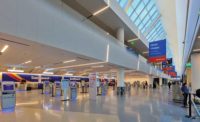ENR California's 2017 Best Projects
Airport/Transit Best Project: LAX 2nd Level Roadway and Central Terminal Improvements

Most travelers at Los Angeles International Airport experience the controlled chaos that occurs on the second-level roadway that serves nine terminals.
PHOTO: COURTESY OF MYERS AND SONS CONSTRUCTION LP

Most travelers at Los Angeles International Airport experience the controlled chaos that occurs on the second-level roadway that serves nine terminals.
PHOTO: COURTESY OF MYERS AND SONS CONSTRUCTION LP


LAX 2nd-Level Roadway and Central Terminal Improvements
Los Angeles
Best Project
Owner: Los Angeles World Airports
Lead Design Firm: Atkins
General Contractor: Myers and Sons Construction LP and J. Banicki Construction Inc., a Joint Venture
Structural Engineer: PacRim Engineering Inc.
MEP Engineer: AECOM
Most travelers at Los Angeles International Airport experience the controlled chaos that occurs on the second-level roadway that serves nine terminals. The $81.6-million project to improve the roadway and central terminal at the fourth-busiest airport in the world could only be completed in limited, overnight work windows.
The team developed new construction methods to save time and minimize the project’s impact on airport operations. Instead of rerouting pedestrians and vehicles around the project, the team moved nearly all the work away from the traffic flow.
The team began by looking at work plans for the project’s 48 individual bridge joints. The original falsework plans called for structural piers located in the center of sidewalk and commercial island locations.
“We recognized early that every element of the project—from the canopies to the light band to roadway and structures reconstruction—was affected by our closure work for the bridge joints. And, conversely, all of this work had the potential to negatively impact LAX operations, passengers and the public in turn,” says Micaiah Revero, project manager at Myers-Banicki.
So the team developed an “inline hinge support method” in lieu of traditional “lift from below” falsework applications. Structural steel members were mounted on the underside of the bridge deck at the “landing side” of each hinge joint. These were cantilevered across the joint under repair and pneumatic lifts were positioned at the “free end” of each to raise the bridge deck.
“It was amazing how this inline solution worked,” says Ronnie A. Villarreal, project engineer with Los Angeles World Airports. “Each step in replacing the bearing pads was simplified, access was easier and overall rework went down as we perfected the process across the first few hinge locations.”
Crews also installed a mile-long light band, a job made more complex by a network of known and unknown steel and abandoned utilities within the concrete section.
Related Article: Communities Are the Real Winners






